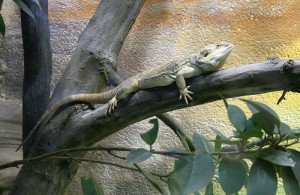An Introduction To Bearded Dragon Species
 There are many different breeds of Bearded Dragons, all of which are in the Pogona family. Patrick Willmott knows a lot about these lizards, and has written this post to give you some background knowledge in the different bearded dragon species.
There are many different breeds of Bearded Dragons, all of which are in the Pogona family. Patrick Willmott knows a lot about these lizards, and has written this post to give you some background knowledge in the different bearded dragon species.
Overview – Bearded Dragons Species
By Patrick Willmott
The eight species of bearded dragons have been named after the areas or regions in Australia in which they are naturally found, with the exception of the Dwarf, Kimberly and Black Soil Bearded Dragon. Common names for these fascinating lizards include the Central or Inland Dragon, the Western, the Eastern, and the Northwest Dragon. The Central type is the most common domesticated lizard.
Most of these reptiles share the same characteristics, and most are semi-arboreal. This means they spend part of their days clambering on tree branches and the other part of their day, on the ground. Most of their time however, is spent on the ground which is why when purchasing or building a cage for your dragon it is best to have more ground space than height. All species are omnivorous and as such their diet includes a mixture of plants and meat. All eight bearded dragon species are sun worshipers and spend much of their day soaking up the sun’s warmth.
The central bearded dragon is the most common lizard type that is kept in captivity, though breeders are now offering the other bearded dragon species as pets. The Central lizard’s natural habitat is woodlands and rocky desert or semi desert areas, so these reptiles are expert tree climbers and enjoy clambering on rock faces. As a norm, dragons in the wild are not social creatures and are normally seen alone. There are times when gatherings of dragons are spotted especially at well-known feeding places or in basking areas. As a rule, most of the species are loners.
As a whole, all species are docile creatures and because these exotic pets thrive in captivity, the central or inland dragon is being bred for the purposes of pets. By recreating their natural habitat in a vivarium or cage, the dragons live a happy and fulfilling life. Most of the species share common lizard characteristics, and differ only by skin tone or by size. All dragons are generally hardy creatures and because they are relatively easy to care for in captivity, their attractiveness as being family pets is growing fast.
Interestingly, though this specie of bearded dragon can now be found all over the world, in the mid 1960’s, Australia passed a law that prevented the trade of any native wildlife, including bearded dragons. Most of the Australian native lizards found outside the country were illegally smuggled and then used to breed. Over the years, breeders have carried out experiments to alter the skin colors or tones and they have successfully managed to breed dragons with unusual colors, such as red and gold hues.
With the inland or central dragon being the most common of the species, much of lizard’s common characteristics and features were learnt by studying this particular specie of lizard. Another name that the inland dragon goes by is the Yellow Headed Bearded Dragon.
At maturity, the lizard reaches at least two feet in length, including its tail. To accommodate this and most other species, a vivarium of at least 55 to 60 gallons is required. To replicate the environmental settings of the Australian lizard’s natural habitat, the temperature should be set at 88 degrees Fahrenheit, and the basking temperature needs to be between 95 and 100 degrees Fahrenheit.
For the first time lizard keeper, the bearded dragon species that is highly recommended as a pet is the central or inland dragon. Most breeders only breeding this particular specie and sourcing this breed of lizard should be relatively simple.
Be sure to follow the www.beardeddragonscare.com guidelines on how to correctly care for your pet dragon. For more information on bearded dragons species and their origins visit Bearded Dragons Care.
Article Source: http://EzineArticles.com/?expert=Patrick_Willmott
http://EzineArticles.com/?Overview—Bearded-Dragons-Species&id=5422441
 December 2, 2010
В·
December 2, 2010
В·  Maddia (Admin) В·
Maddia (Admin) В·  Comments Closed
Comments Closed
 Tags: bearded dragon species, bearded dragons, central bearded dragon В· Posted in: Bearded Dragons, Lizard Care
Tags: bearded dragon species, bearded dragons, central bearded dragon В· Posted in: Bearded Dragons, Lizard Care


